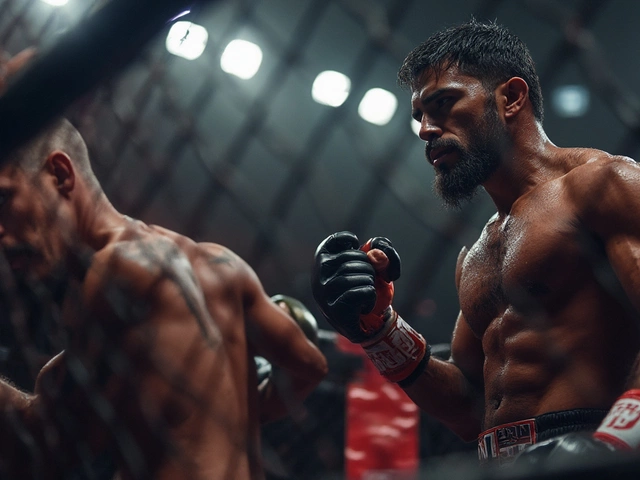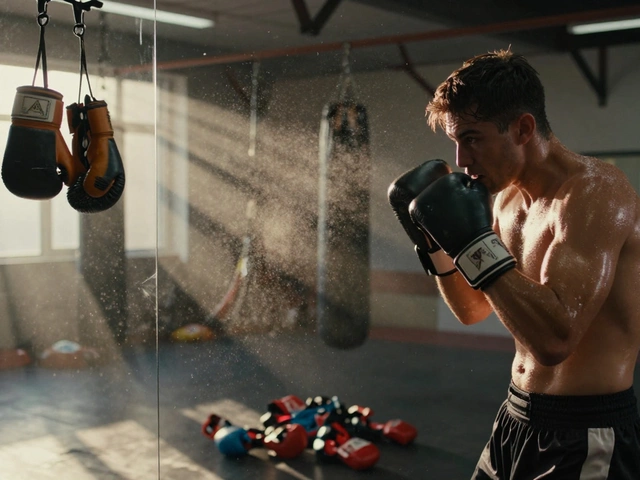If you’re wondering whether a boxer can step into the MMA cage and just dominate, you might want to pause. Punching power and fast hands are great, but MMA is a whole different game—kicks, takedowns, chokes, and a lot less predictability than a boxing ring. So, yes, boxers can move to MMA, but most are in for a serious wake-up call if they skip the hard work of learning new skills.
It’s easy to underestimate the difference. Sure, some skills transfer—distance control, good head movement, and that killer jab. But suddenly, you have to deal with leg kicks that smash your calves, clinch fights you never see in boxing, and the ever-present threat of someone taking you to the ground. Even the best boxers in the world have looked lost once the fight hits the mat.
If you’re a boxer thinking about MMA, it pays to watch how others have done it. Pay attention to their mistakes, and notice how long it took them to get comfortable in the cage. Skill alone won’t save you—adaptability and a willingness to start from scratch are way more important. Want to avoid getting steamrolled your first time out? Learn which gaps to close first, and don’t expect your fists to carry you through every round.
- Boxers in MMA: A Reality Check
- What Transfers and What Doesn’t
- Famous Boxers Who Tried MMA
- Tips for Making the Jump
Boxers in MMA: A Reality Check
It sounds thrilling—a pure boxer stepping into the wild tornado of an MMA cage. But reality doesn’t play out like a highlight reel. Even the best in the sweet science have struggled when the rules change, and that’s just the start.
MMA isn’t just boxing with extra moves. In fact, most boxers who’ve tried MMA hit a wall fast. James Toney, a three-division world champ, lasted about three minutes in the UFC before being tapped out by Randy Couture back in 2010. No jab, hook, or uppercut could help once it hit the mat.
And it’s not just about skill—conditioning and mindset get put to the test. Boxing rounds are three minutes with predictable breaks, but MMA throws you into five-minute rounds full of wrestling, striking, and constant adrenaline spikes. That’s tough, even for elite athletes.
“Some of the best boxers in the world get humbled quickly under MMA rules. It’s another beast completely.” – Joe Rogan, UFC commentator
Don’t overlook the injuries, either. A study from Clinical Journal of Sports Medicine found MMA fighters have three times the injury rate per match compared to boxers. That means a boxer isn’t just learning new skills, but learning to survive new risks.
| Aspect | Boxing | MMA |
|---|---|---|
| Fight Duration | 12x3 min rounds | 5x5 min rounds (title fights) |
| Allowed Strikes | Punches only (above the belt) | Kicks, punches, elbows, knees |
| Legal Techniques | No grappling | Striking & grappling, submissions |
This isn’t to say boxers can’t adapt, but the jump to MMA is a huge leap. Most who try come in underprepared and leave with a whole new respect for the sport—and usually some bruises to go with it. If you’re a boxer eyeing MMA, know that reality isn’t always kind to crossovers.
What Transfers and What Doesn’t
If you’re a boxer looking to test your skills in MMA, you’ll be happy to know that some tools in your kit actually carry over pretty well. Footwork, for one, makes a massive difference. Good movement and the ability to control distance help you avoid shots and set up your own strikes, just like in the ring. A sharp jab? Still a weapon. It’s a quick way to mess up an opponent’s rhythm—even when they’re worrying about kicks and takedowns.
Hand speed and timing are also top assets that intimidate many MMA fighters, especially those without a boxing background. Plus, boxers tend to have a better sense for head movement and slipping punches than most mixed martial artists. This helps against strikes, at least as long as kicks or takedowns aren’t on the table.
- What Transfers:
- Footwork and distance control
- Punching technique and combos
- Hand speed and accuracy
- Head movement and defensive skills
Now for the catch—here’s what doesn’t transfer straight over. The lack of experience with kicks is the big one. Most boxers get totally thrown off by calf kicks and body kicks. A boxer’s wide stance, designed for power punches, leaves the lead leg exposed to chop-downs in MMA. Add elbows, knees, and a whole lot of clinch wrestling, and it gets trickier. Jiu-jitsu and wrestling? Boxing doesn’t cover any of that, so most boxers find themselves either stuck in bad positions or flat on their back.
- What Doesn’t Transfer:
- No experience defending leg/kicks or checking kicks
- Weakness in clinch fighting
- No training for takedown defense
- Lack of submissions, ground fighting
If you need proof, just look at some crossover bouts in the past decade. According to fight stats from several UFC events, boxers absorb far more leg kicks than fighters with even basic kick defense training. And once a fight hits the floor, most new crossovers from boxing last less than a round before being submitted or grounded and pounded. That’s not to say it’s impossible, but there’s a huge learning curve that most boxers underestimate when they enter the MMA cage.

Famous Boxers Who Tried MMA
Plenty of people talk about how tough it is for boxers to switch to MMA, but nothing says it like real-world examples. Several well-known boxers have given MMA a shot—some just for the headlines, others with genuine ambition to compete.
Probably the most talked-about case is James Toney. He was a multi-weight world champion with years of experience in boxing. At UFC 118 in 2010, he went up against Randy Couture, a wrestling machine and MMA legend. Toney’s confidence was sky-high, but in less than four minutes, Couture took him down and finished him with an arm-triangle choke. Toney barely landed a clean punch. He later admitted he wasn’t ready for all the wrestling and submissions.
Another big name—Holly Holm. She’s one of the few boxers who made the jump and hit it big. Holm held multiple boxing world titles before moving to MMA. Instead of jumping right into the deep end, she trained hard for years, fought in smaller promotions, and worked on her kicks and grappling. Her patience paid off when she famously knocked out Ronda Rousey to win the UFC bantamweight title in 2015. Holm didn’t just rely on her boxing—she added the missing pieces to become well-rounded.
Ray Mercer, an Olympic gold medalist and former WBO heavyweight champ, also took his shot at MMA. He lost to Kimbo Slice—mostly known for street fights—in his MMA debut. But here’s the twist: Mercer later shocked fans by knocking out former UFC champ Tim Sylvia with the very first punch in their MMA fight.
- James Toney: Legendary boxer who failed to deal with takedowns and submissions.
- Holly Holm: Transitioned with patience, added new skills, and became UFC champ.
- Ray Mercer: Lost to a brawler, but later KO’d a UFC veteran using raw punching power.
The real takeaway? Even the most decorated boxers can struggle in MMA if they don’t fully commit to learning new things. But with focused training and a humble attitude, it’s not just possible—it’s doable. These stories make it clear: Switching from boxing to MMA isn’t just about throwing hands. You have to embrace everything else the cage brings.
| Boxer | MMA Debut | Result | Key Lesson |
|---|---|---|---|
| James Toney | UFC 118 (2010) | Lost by submission | Lack of grappling = big problem |
| Holly Holm | Legacy FC 21 (2013) | Won; later UFC champ | Patience, all-around game |
| Ray Mercer | Cage Rage 6 (2007) | Lost (then later won by KO) | Power helps, but skills matter |
Tips for Making the Jump
Thinking about taking your boxing background into MMA? Here’s what actually matters. First, you can’t skip learning the basics of wrestling and Brazilian jiu-jitsu. Shoot defense—literally being able to sprawl when someone dives for your legs—might be the single most important thing if you want to last more than a round. Guys who ignore this end up flat on their back and lost.
It’s not just about stopping takedowns, though. You’ll need to know how to get back up if you do hit the mat. That means drilling escapes, wall-walking, and even basic submissions, just to avoid tapping out instantly. If you can learn to avoid getting caught in guillotines or rear-nakeds, you’re already ahead of a lot of first-timers.
Kicks are another reality check. Boxing footwork doesn’t prep you for shin-splitting low kicks. Spend a chunk of your training time just blocking and checking kicks. Coaches will tell you: some ex-boxers limp out of their first MMA spar because they ignored this.
- Sign up at an MMA-specific gym, not just a regular boxing club with a couple of heavy bags.
- Spar often in full MMA rules, not just boxing or kickboxing. Cage walls, wrestling, and short gloves change everything.
- Watch out for cardio—the stop-and-go pace in MMA is brutal compared to a 12-round boxing fight. Grappling will make you feel out of shape, even if you’re running five miles every day.
- Pick the right camp. Well-known MMA facilities have specific transition programs for boxers. Jackson-Wink in Albuquerque and American Top Team in Florida are famous for this kind of work.
Here’s a quick look at how some pro boxers managed the switch:
| Boxer | MMA Debut Age | MMA Record | Known For |
|---|---|---|---|
| James Toney | 42 | 0-1 | Lost to Randy Couture by submission after just seconds on the ground |
| Holly Holm | 29 | 14-6 (as of 2024) | Knocked out Ronda Rousey; multiple-time boxing world champ |
| Marcus Davis | 32 | 22-11 | Spent time in both UFC and boxing |
Notice a pattern? Success comes when fighters show up humble and put in the work—not just expecting a strong cross or hook to solve every problem. Remember, a crossover to MMA is more like switching sports than switching gyms. Go all-in, respect the details, and take lumps in training, not during your debut.




